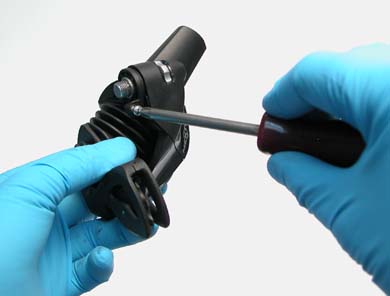Rear Derailleur Overhaul
This article will discuss the overhaul of rear derailleurs and pulleys.
Derailleur Wear
- Hex wrenches
- Screwdrivers, narrow straight blade and #2 Phillips
- Work tray for small parts
- Seal pick (optional): UP-SET
- Bench vise (optional)
- Grease: PPL-1 PolyLube 1000
- Degreaser for cleaning small parts, such as CB-4 Bio ChainBrite™
- Light lubricant such as CL-1.2
Some rear derailleur models allow the internal servicing in order to clean and lubricate. This often improves performance by removing dirt from pivots. Additionally, some models allow for the changes to the pulley cage tension spring. There are also after-market top pivot “break-away” bolts, which may be installed in place of the original mounting bolt.
The rear derailleur will become worn with use and abuse. As the derailleur wears, it will develop play at all pivot points. Grab the cage at the lower pulley of a new derailleur while mounted to a bike and wiggle it side to side. Do the same test on an old model to compare. Replace derailleur when this play becomes significant.
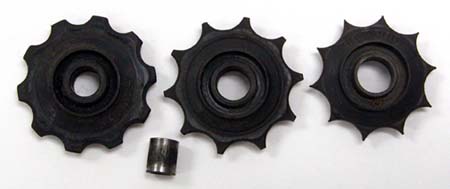
Derailleur Service
It will be useful to have a note pad and pen to help you remember correct orientation of parts. Sketch any parts that seem unfamiliar, or use a digital camera for the same purpose. Have some wire ties or twine on hand to help tie parts in their correct orientation as they come apart.
Begin by removing the rear derailleur from the bike. For bicycle chains with no master-link, the cage may be dismantled, which allows the chain to stay together.
Note and record any marking distinguishing upper and lower pulley. Also note the orientation of the cage. Loosen and remove both derailleur pulley bolts. Remove the cage and chain from the derailleur.
Shimano®
Shimano uses a tension spring in the upper pivot, at the mounting bolt. The pulley cage also uses a spring. The two springs oppose each other. Changes in spring tension will cause the body of the derailleur to rotate, causing changes of upper pulley relative to the larges cog. Increasing the tension of the pulley cage will require increasing tension in the upper pivot. If the upper pivot B-screw adjustment is already as tight as possible, do not change tension in the pulley cage to a higher tension setting.
The procedure for derailleur overhaul is as follows:
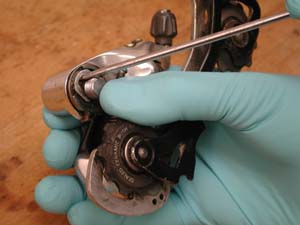
- Use a thin tipped screwdriver to pry off the C-clip on the back side of the derailleur mounting bolt. Work over a table to avoid losing parts. Maintain pressure on the B-screw plate against the body while removing the clip. This helps prevent parts from flying off as spring tension is released.
- Remove body-screw plate from derailleur body. Note and write down orientation of parts. Note especially any seals and the direction of seal lips.
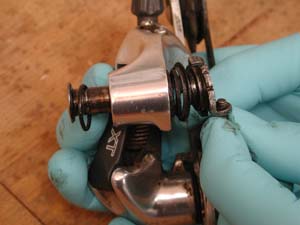
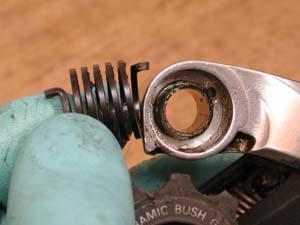
- Remove the lower cage from the derailleur body. There are several different systems of cage attachment. Many models from Shimano® use a screw under the body, called the P-screw. This screw holds a stud mounted to the pulley cage. To prevent premature release of cage spring tension, hold derailleur cage firmly to derailleur body and remove this screw using hex wrench.
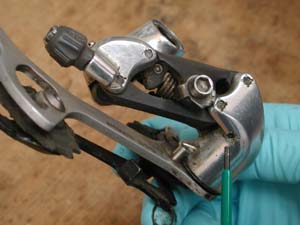
- Alternatively, there may be a set screw in the derailleur cage that acts as a stop. Pivot cage away from stop, and remove set screw, then allow derailleur to unwind. Note direction cage unwinds for reassembly.
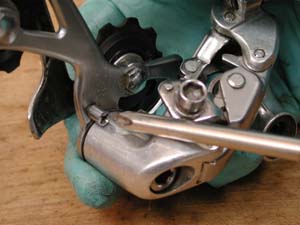
- For P-screw type derailleurs, hold both derailleur body and derailleur cage. Pull cage away from body and allow cage to unwind. Note direction the cage unwinds.
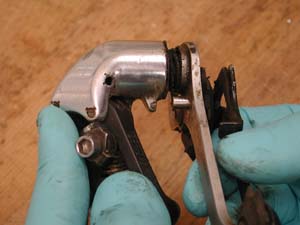
- The derailleur cage may be held to the body with a pivot bolt. The bolt head may face toward outside, away from the spokes, or it may face inside, facing the spokes. Loosen and remove bolt. Note and record any washers or seals found on bolt or on cage.
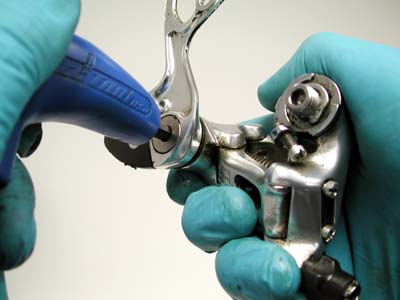
- As cage is removed from body, make note of the spring hole in the derailleur cage and body. There are commonly two or more hole choices. New derailleurs are typically assembled with the spring in the hole that allows the most relaxed position of the spring. If more cage tension is desired, the spring end can be installed in the other hole.
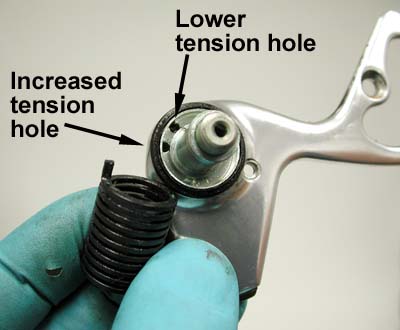
- Remove spring from inside derailleur body. Note especially the direction of the coil ends. The smaller end tends to face toward the derailleur cage, and the larger end goes into the derailleur body. There is commonly a seal as well. Note direction of lip.
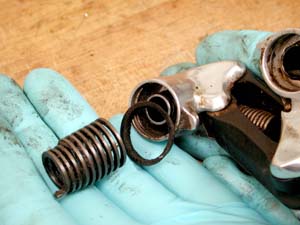
- If derailleur cage is still together, loosen and remove one at a time each pulley bolt. It is common for the upper and lower pulleys to be different. Do not mix parts from upper and lower pulleys. Upper pulley may be labeled as “G” pulley, or simply “upper”.
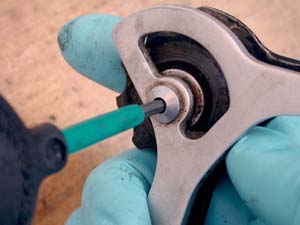
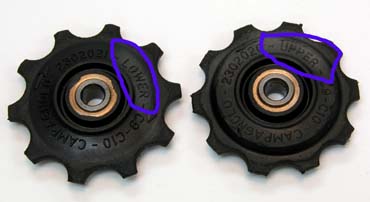
- Note parts orientation of cover plates, seals, and bushing. Use a wire or string to tie these parts together in the correct orientation.
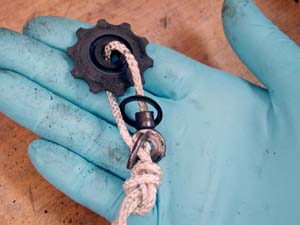
- Some pulleys have have a cartridge type bearing. Use a seal pick to carefully lift the seal from the inside edge.
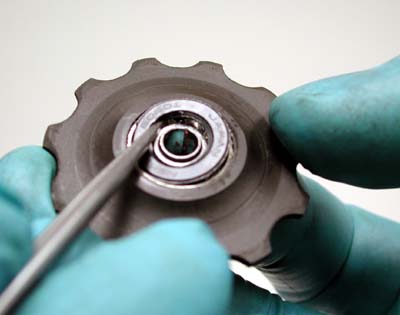
- Clean all parts in a degreaser and dry. Use compressed air if possible, but do not allow bearings to spin.
- Use a light lubricant on pulley bushings and seals. Assemble pulleys into cage in the same orientation as they were disassembled. Remember to refer to your notes on orientation. Install and tighten pulley bolts to about 30 inch-pounds. Use of a mild threadlocker is recommended.
- Cover both springs heavily with grease.
- Install cage spring into derailleur body, with smaller tapered end of spring facing outward toward cage. Be sure to engage spring into spring hole inside body. Place dust seal over derailleur body as it came off.
- Engage cage spring into derailleur cage and body. Again refer to notes from disassembly. Changing spring hole location will change tension. In the image below, spring is in most relaxed position. Seen from this orientation, cage will be rotated counter-clockwise for working tension.
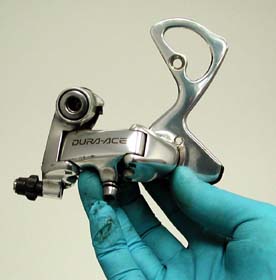
- In the image below, the spring is engaged in the higher tension spring. Notice cage must now be wound further counter-clockwise, adding to spring tension.
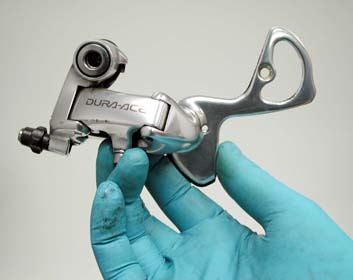
- Press cage into derailleur body and begin to rotate derailleur cage toward back of derailleur. It is important to always wrap the spring tighter in the same direction as the coil.
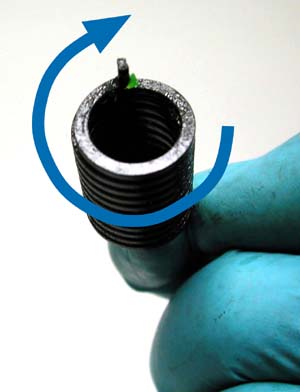
- Looking at the back side of the derailleur (opposite side of brand name) rotate cage clockwise to tension spring.
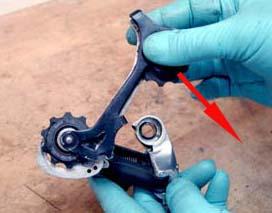
- For P-screw type derailleurs, cage stop and derailleur body stop must clear. Pull slightly outward on cage and allow the two stops to pass. Push cage fully into derailleur body once stops are cleared.
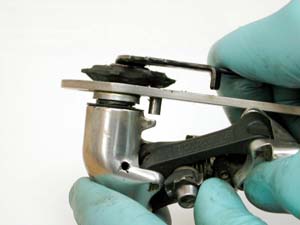
- For bolt type pivots, rotate cage until you can access stop screw.
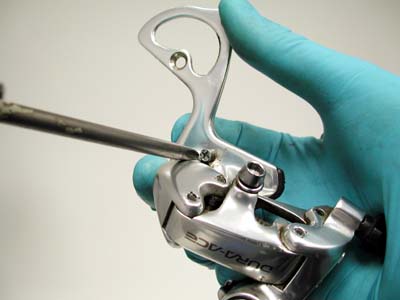
- For P-screw type, reinstall set screw into derailleur body.
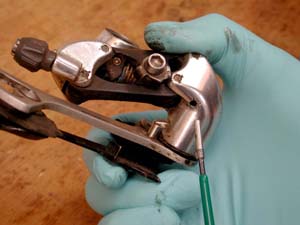
- Mounting bolt spring can be difficult to engage and tension. It is useful to mount a hex wrench with the short “L” facing upward in a vise. The vise and wrench act as a holder and frees up your hands.
- Install spring into body in same orientation as it came apart. Note direction of spring coils, which will indicate the direction of tensioning spring. Place dust seal over spring. Engage body tension plate on spring. Press plate fully down to see if plate will fully engage system.
- Using needle nose pliers, grab body angle screw.
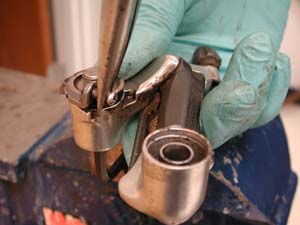
- Again, tension spring with direction of wrap. Upper pivot springs wrap counter-clockwise. Rotate plate counter-clockwise to tension spring. Pull plate upward enough to clear stop tabs on each.
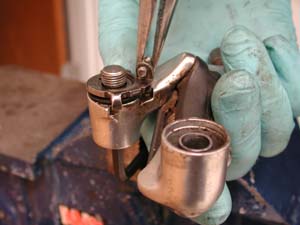
- Push downward on plate and hold pressure downward before installing C-clip.
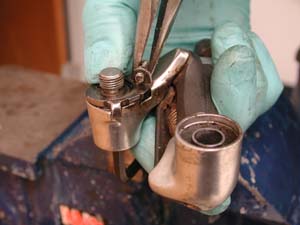
- Install C-clip onto mounting bolt. Use needle nose pliers to fully engage C-clip.
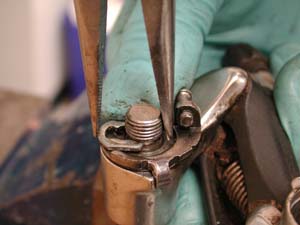
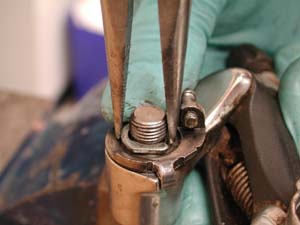
Campagnolo®
The Campagnolo derailleurs share many service features of the Shimano derailleurs. Both upper and lower pivots have a spring. The derailleur is fully serviceable.
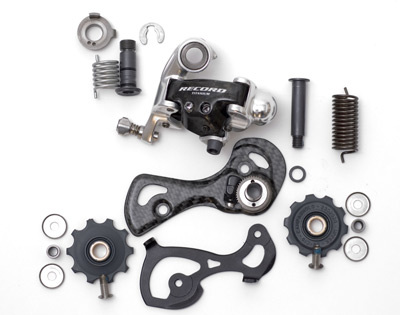
- Remove C-clip from upper pivot. Use screw driver and same procedure as described in Shimano above. Note hole in plate that holds spring end.
- Remove both pulley wheel bolts and inner pulley cage.
- Loosen cage pivot bolt. Use care and proceed slowly as cage will unwind as it clears cage stop.
- Remove spring from derailleur body.
- Clean all parts.
Assembly
- Grease all springs.
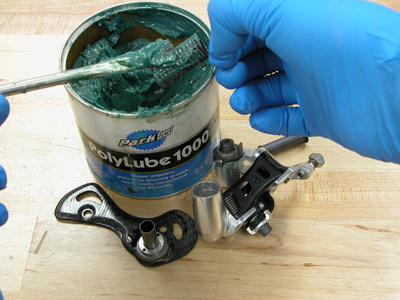
- Install the shorter spring in the upper pivot. Select the correct spring hole in the plate. One hole will require the plate be wrapped more and this increases upper pivot tension. This would result in pulling the derailleur back and away from the cogs.
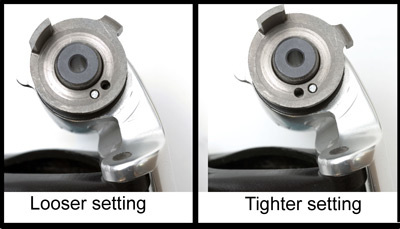
- It can be useful to mount a hex wrench in a vise to hold the derailleur body and bolt. Rotate the place counter-clockwise and press downward to engage plate stop against body stop. Engage C-clip using needle nose pliers.
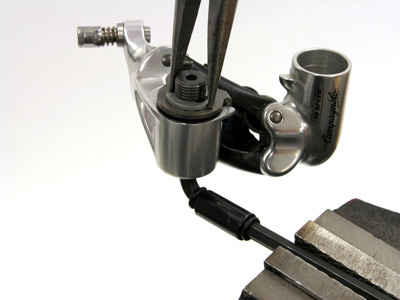
- Install lower pivot spring into derailleur. Insert bolt through cage and place spacer at end.
- Insert cage and bolt into derailleur body. Insert spring into cage spring hole.
- Rotate cage to tension spring.
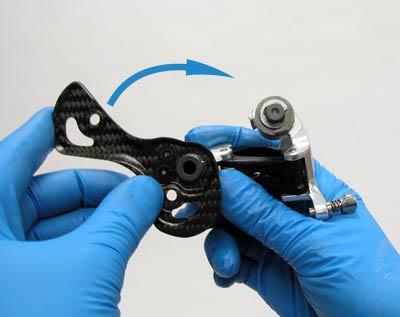
SRAM®
- Push cage to body once it passes cage stop. Carefully thread bolt and secure.
- Install both pulley bolts. The upper pulley is marked “upper.” Use a mild thread locker on the pulley bolts.
SRAM® X0 Derailleurs
The X0 derailleur may be overhauled at the lower cage pivot. The mounting bolt has no spring, and it is best to leave this bolt in place. No lubrication of the mounting bolt pivot is recommended.
The SRAM® parallelogram spring is very strong. It is possible to use a zip tie to hold the derailleur body away from the cage, making it easier to work with the cage. Feed a zip tie through the body below the cable stop, and through the cable guide. Pull the cage away from the body as if shifting toward larger cogs, and secure the zip tie to hold the body.
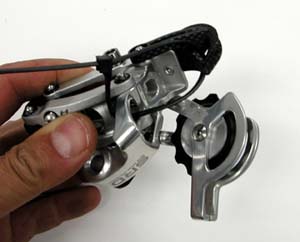
Lower Pivot Overhaul Procedure
- Rotate cage to expose the cage stop screw. Loosen and remove the stop screw. Cage will now rotate back past the stop screw position.
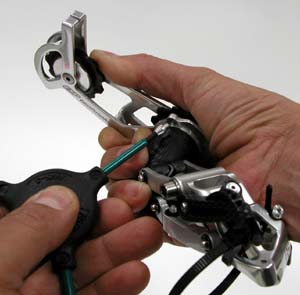
- Allow cage to rotate forward and relieve spring tension. Note position of cage to derailleur body in this relaxed position.
- The pulley cage is held to the body with a stud pressed into the cage. The stud has a “D-fitting”, that mates with a D-shape recess in the body. The body must be rotated to one position only before the cage can be removed.
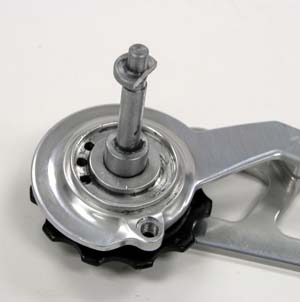
- There are three tension options in the cage, as seen in image above. The middle spring hole is used on new derailleurs. To decrease chain slap, increase spring tension by moving spring to left hole of the three choices, as seen from the stud side.
- After removing the pulley cage, loosen and remove pulley bolts. Pulleys use a cartridge bearing, use care when removing seal.
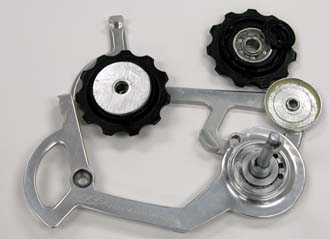
- Clean all parts in a degreaser. Pack grease into seals of pulleys and reinstall seals. Pack grease into cage pivot spring.
- Assemble pulley wheels into cage and install pulley bolts. A mild thread locker is recommended on the threads. Spin pulleys to check proper for alignment after securing bolts.
- Place spring into body of derailleur in same orientation as it was removed. Engage spring end into desired cage hole.
- Push cage to derailleur body. Cage must rotate to allow “D” fitting to engage into body. Approximate position of cage to body for “D” fitting alignment is shown below.
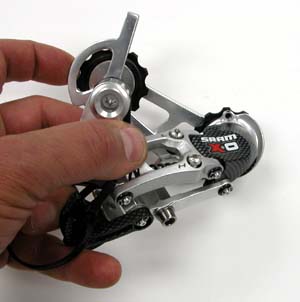
- Rotate cage counter-clockwise as seen from orientation of image above. Install and secure cage stop screw. Remove zip tie. Derailleur is ready to be installed.
SRAM® Force and Rival
The SRAM® Force and Rival rear derailleur use an upper pivot bolt that has no internal spring. It may may be cleaned and lubricated without disassembly. The pulleys may be removed for cleaning. The lower cage pivot the should not be taken apart.
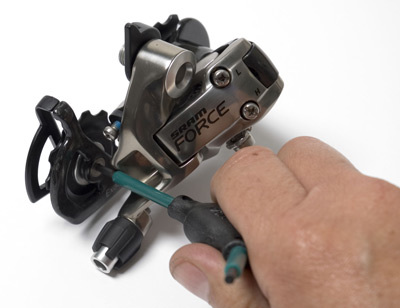
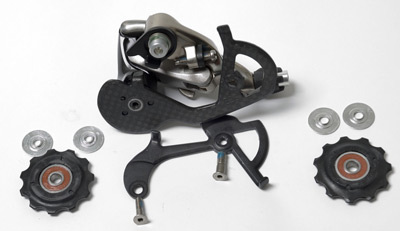
Mavic® Mektronic
The Mavic® Mektronic derailleur has many internal parts, including electronic parts. There are very few user serviceable parts. The pulley wheels can be brushed clean with a dry bush. Avoid using solvents during cleaning.
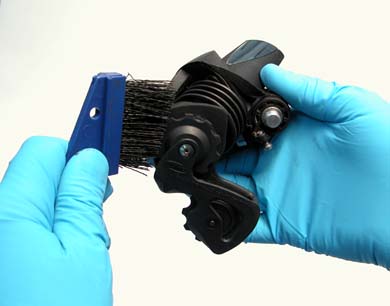
There is a boot covering the arm that extends to shift the pulley cage. Use only a soapy water on a rag to wipe this clean. Use care not get water or soap into the working mechanism.
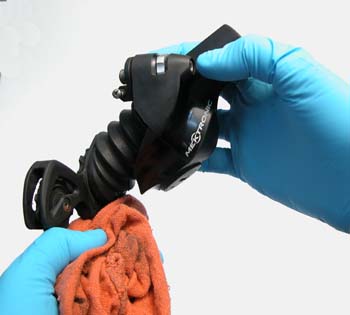
The derailleur uses a solenoid initiate the shift. It is activated by a battery. The battery cover is removed using a 1-Euro coin (substitute US twenty-five cent piece).
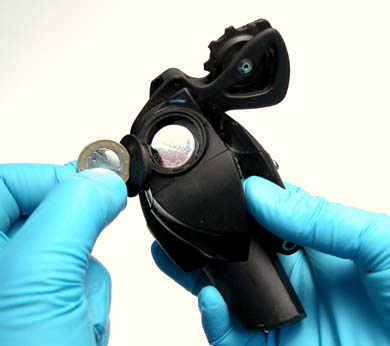
The derailleur B-screw is located at the top mounting bolt. There is a spring in this pivot, but it is recommend the pivot not be dismantled.
